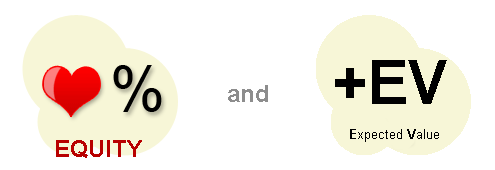The Difference Between Equity and Expected Value (EV)

When I first started to learn about the mathematics involved with poker I thought equity and expected value (EV) were the same thing. The both seem to involve odds and help to show you whether or not your hand or decision is a profitable one.
Despite some similarities, there is a difference between the two and they often work together to help you make profitable decisions (which is probably where the confusion comes in).
In this article I will explain the difference between equity and EV and show you how they are used in poker.
- My article on equity.
- My article on expected value.
Definition of equity and expected value.
- Equity is a percentage (e.g. 70%). Equity tells you how much of the pot “belongs” to you, or to put it another way, the percentage of the time you expect to win the hand on average from that point onwards.
- Expected Value is a monetary value (e.g. +$10.50). It can be positive or negative. EV tells you how profitable or unprofitable a certain play (e.g. calling or betting) will be. We work out EV when we are faced with a decision.
That’s the basics of it, but what’s the relation between these two mathematical concepts in poker?
The connection between equity and expected value.
You need to know your equity to work out your expected value.
Think of expected value as a more advanced version of equity that gives you figures that are easier to work with and use at the table. Equity is the basic raw material that you need to help you create more effective numbers to work with.
When you combine equity with the money you could potentially win or lose after making a certain decision, you come up with your expected value.

Equity is the raw material. If you do a little work with it you end up with EV, which is a more useful value.
Equity and EV connection example.
Hero ($100): A![]() K
K![]()
Villain ($100): T![]() J
J![]()
Board: A![]() Q
Q![]() 4
4![]()
Our Equity: 56%
Pot: $200
According to PokerStove, we have 56% equity on the flop. This means that we have 56% chance of winning by the river and therefore 56% of the pot currently “belongs” to us. Good stuff.
Villain moves all-in on the flop for $100 (making the pot total $300) and we have to decide whether or not to call that $100 bet. To work out how much we expect to win (or lose) on average every time we call, we need to work out our expected value.
- We win $300 56% of the time. $300 x 0.56 = $168
- We lose $100 44% of the time. $100 x 0.44 = $44
- Expected value calculation.
- EV = win - lose = $168 - $44
- EV = +$124
Therefore, we expect to win $124 on average every time we call the $100 all-in from our opponent in this situation. We couldn’t have known that with just the 56% equity figure on its own.
For information on how EV is worked out in more detail, see the main expected value article. Or, for the more mathsy stuff, check out my handy "boxes" method for calculating EV.
Common equity and EV misconception.
You don’t need to have a lot of equity in a hand to have good EV (or +EV in other words).
Equity and EV are not directly proportional.
It’s true that the more equity you have (the more chance you have of winning) the better, but there will be times where you can have low equity in a hand but a positive expected value (+EV).
Quick low equity and +EV example.
Hero ($100): J![]() T
T![]()
Villain ($10): A![]() J
J![]()
Board: A![]() Q
Q![]() 4
4![]()
Our Equity: 11%
Pot: $200
Our opponent moves all-in for $10 in to the $200 pot on this flop.
We only have 11% equity here, which is a very, very low equity share indeed. However, if we work out the EV of calling:
- We win $210 11% of the time. $210 x 0.11 = $23.10
- We lose $10 89% of the time. $10 x 0.89 = $8.90
- Expected value calculation.
- EV = win - lose = $23.10 - $8.90
- EV = +$14.20
Because the bet size is so small compared to how much we can potentially win, it’s a +EV play to call.
In general, to have low equity in a hand but for a call to be +EV, the bet must be small in relation to this size of the pot. This is because you will be risking less and winning more over the long run.
Evaluation of the difference between equity and EV.
If you just remember that:
- Equity is a percentage (e.g. 56%).
- EV is a monetary value (e.g. +$5.25).
You will be able to easily identify which is which.
Knowing why they are different takes a little more effort, but hopefully this article has gone a long way to help explain the main difference between the two.
Go back to the interesting Texas Hold'em Articles.
Can You Afford Not To Use
Poker Tracker 4?
“I wouldn’t play another session of online poker without it”
“I play $25NL, and in under 1 week PT4 had paid for itself”
Comments

